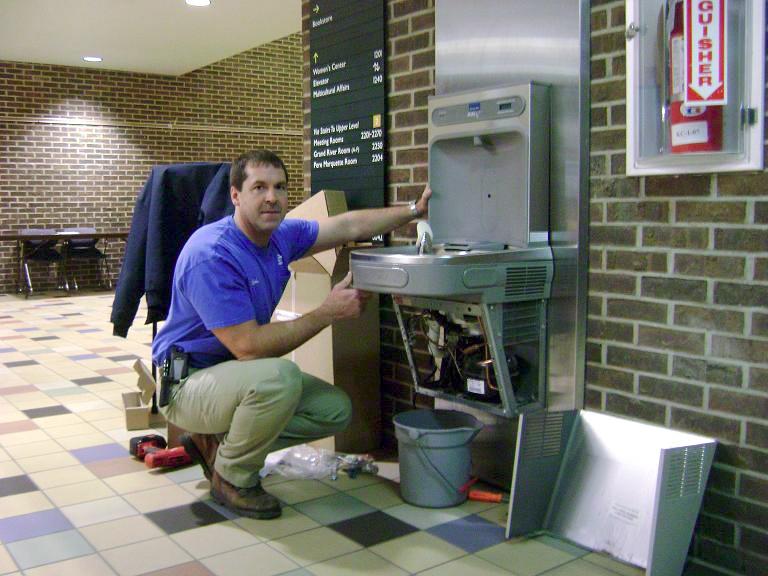GV installs water bottle refilling units to reduce use of disposable bottles

Courtesy Photo / David Feenstra Cristopher Jefferies intalls the new water bottle filling stations in the Kirkhof lobby.
Nov 4, 2010
Last year, the Student Environmental Coalition’s subgroup organization, Students on Tap, reorganized and regenerated, asking students to look at themselves and make a sustainable switch.
The group proposed the idea of water bottle refilling stations paired with some sort of university system for checking out free water bottles to reduce the use of the plastic, disposable water bottles that have currently cornered the market at Grand Valley State University.
“I hope that the conversation we started is going to grow into a larger question students ask themselves, ‘Why am I paying for water that I can get for free?’” said Josh Lycka, organizer of Students on Tap.
In what Maintenance Supervisor David Feenstra calls “coincidental timing,” Students on Tap is making strides toward its goal with the installation of three new “retro-fit bottle-filling units” on campus.
In late summer, Feenstra said Christopher Jeffries, Grand Valley State University’s master plumber on campus, came to him with the idea to add the retro-fit bottle-filling unit to the university’s pre-existing water fountains on campus that would result in not only filtered water from the fountain but also a unit on top that uses an infrared light that reads when a bottle is there and shuts off when the bottle is removed.
“You’re adding the device to the drinking fountain, so not only do you have the drinking fountain; you have this to fill your bottle above it,” Jeffries said. “It’s a retro-fit kit to a pre-existing water fountain. Not only are you filtering the drinking fountain, you’re filtering the water that comes out of the bottle filler.”
The water comes directly from the water supply and passes through the filter and then the evaporator, producing chilled, filtered water that dispenses from both the pre-existing bubbler on the original unit as well as the new bottle-filing unit. Each filter is good for about 3,000 gallons of water, which, depending on bottle size, can average out to 30,000 uses. This would require the purchase of a new filter for the unit once every year or so, again, depending on amount usage.
“Refilling water containers is more sustainable since fewer plastic bottles would make it to the waste stream,” said Tim Thimmesch of Facility Services. “Plus there is a cost savings to students if they can refill from our water fountains rather than purchasing new.”
As of right now, three units have been installed on GVSU’s Allendale Campus — one in Manitou’s second-floor computer lab, another on the middle floor of the Fieldhouse training area and most recent in the Kirkhof Center’s lobby.
Both Feenstra and Jeffries said response to the new units has been overwhelmingly positive thus far into the trial period, which the pair estimate will run through the end of the 2010 calendar year.
Currently, there is no funding for the retro-fit bottle-filling units, which can run anywhere from $450 to $600 for the more contemporary fountain models and $1,200 to $1,500 for the older models that need a more comprehensive facelift.
The budget so far has come directly out of Feenstra’s operation budget as a test, he said. Provided the units continue to be met with general acceptance and high usage, Feenstra and Jeffries speculate that the main lobby of the Performing Arts Center along with Manitou’s main floor lobby are both likely candidates for the next unit. Both said there is a potential goal of one unit per building if this trial period continues to thrive.
“Down the line if we get funding or money to do more of them, then sure, but right now we’ve got to be careful because we’re on a budget,” Jeffries said.
Feenstra, in conjunction with Norman Christophers from Sustainability Community Development Initiative, is currently exploring possible funding options for future development of the units, which Lycka and the rest of the Students on Tap group are already rallying around.
“We’re pursuing a reinvestment fund application through the Sustainable Community Development Initiative to get money for at least one new water station on campus,” Lycka said.
Lycka said the proposed station would also include an additional posting of information about water policy and the science and economics behind the water bottle industry.
Both Lycka and fellow Students on Tap member Katie Sexton said capturing the student body’s attention and calling for a university-wide re-evaluation is critical to furthering a more sustainable GVSU.
“Grand Valley is noted for its achievements in sustainability, but even so, bottled water is the biggest money maker for campus dining,” Sexton said. “I think it’s time to step back and contemplate the values the university strives to uphold and whether or not these are what is really being supported with the current system.”























